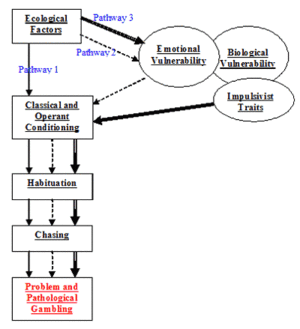The WAGER, Vol. 8(2) – Psychological Profiling: Classification and the Problem Gambler
Blaszczynski and Nower (2002) argue that “the quest to impose one theoretical model to apply equally and validly to all pathological gamblers is a misguided venture.” The authors contend that placing problem gamblers in a treatment system that accommodates specific sub-groups based on biological, psychological, and ecological factors will ultimately yield more effective treatment. The framework developed by the authors (see Figure 1) identifies three sub-groups, or “pathways,” to describe problem gamblers: behaviorally conditioned problem gamblers, who repeatedly exhibit poor judgment by engaging in destructive gambling behaviors, but lack a specific psychiatric pathology (pathway 1); emotionally vulnerable problem gamblers, who experience gambling problems as a result of depression, anxiety, or other emotional disorders (pathway 2); and antisocial impulsivist problem gamblers, who engage in reckless and spontaneous gambling sessions and typically exhibit signs of antisocial personality disorder, emotional vulnerability, multiple addictions, and other comorbid psychiatric conditions (pathway 3).
Figure 1. Pathways Model of Problem Gambling (Blaszczynski & Nower, 2002)

The authors suggest that problem gambling is always initiated through ecological factors (e.g., availability and accessibility of gambling facilities) and then, depending on the biological and psychological traits of the individual, can proceed through one of these three pathways until gambling becomes problematic.
While the framework presented by the authors represents a theoretical advancement in the treatment of problem gambling, its practicality as a clinical treatment instrument is uncertain. Because problem gamblers likely exhibit similar behavioral characteristics irrespective of their subgroup, a great deal of research is needed to develop the tools necessary for the proper clinical identification of patients within this system. In addition, while this framework attempts to categorize different types of problem gamblers, it ultimately leads all three types of gamblers down the same path: conditioning, habituation, chasing and problem gambling. This could be an oversimplified view of the experiences and conditions that lead to problem gambling by individuals across and within the established categories. Similarly, the figure as presented by Blaszczynski and Nower fails to represent the large differences in magnitude and severity of gambling problems experienced by individuals across the three groups.
This article identifies several characteristics of problem gambling and isolates three progressive sub-categories of problem gamblers. Such a framework will likely prove useful as science continues to develop the most effective and appropriate treatment and recovery strategies for those with gambling problems.
Comments on this article can be addressed to Tony Donato.
References
Blaszczynski, A., & Nower, L. (2002). A pathways model of problem and pathological gambling. Addiction, 97(5), 487-499.